Against the backdrops of global warming, the overall warming and wetting of the Tibetan Plateau (TP) has led to the increase of land evapotranspiration and the adjustment of surface energy budget. What are impacts of these surface energy changes on precipitation? To address the above question, Yang Kun's Research Group of the Department of Earth System Science (DESS), Tsinghua University analyzes the interdecadal variations of the surface energy budget and precipitation during the monsoon period (May-August) in the TP from 1979 to 2021, and on this basis, reveals the impacts of the plateau surface energy variations on the climate.
The reanalysis data show that since the mid-1990s, latent heat flux and precipitation have increased significantly, whereas sensible heat flux has decreased over the TP, hence the reduction of the corresponding Bowen ratio. Meanwhile, precipitation has increased (Fig. 1). To explore the impacts of the above surface energy variations, it is necessary to realize a reasonable change in the proportion of surface energy distribution in the regional climate model. The commonly used adjusted soil resistance scheme will inevitably destroy the water balance of the simulation system, while the scheme of changing the surface albedo will lead to the change of surface net energy. The defects of these methods are salient.
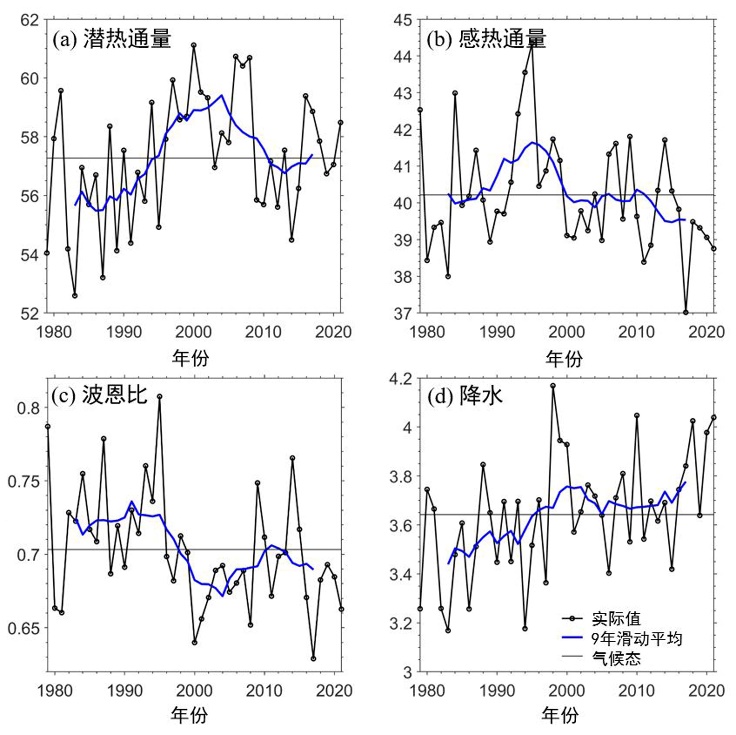
Fig. 2. Time series of monsoon-season (a) latent heat flux (W·m-2), (b) sensible heat flux (W·m-2), (c) Bowen ratio (no dimension), and (d) precipitation (mm·d-1) averaged over the TP based on the ERA5 reanalysis data. The horizontal line indicates the 1979-2021 climatology, and the blue line is the 9-yr running mean.
Different from the previous methods, the research, by changing the surface resistance scheme of soil evaporation in WRF simulation of regional climate model, realizes reasonable change of the TP surface energy distribution. Two soil evaporation surface resistance schemes are adopted in the research, namely the Sakaguchi and Zeng (2009) scheme (SZ09) and the revised Sellers et al. (1992) scheme. When the surface soil liquid water is the same, the estimated surface resistances of the SZ09 scheme are generally greater than those of the AS92 scheme, causing less evaporation and more sensible heat. Based on the two surface resistance schemes, two numerical experiments are designed in the research: The first experiment (WRF-CTL) is conducted with the SZ09 scheme. The second experiment (WRF-SEN) replaces the SZ09 scheme with the AS92 scheme on the TP; otherwise, the same as the WRF-CTL. Therefore, compared with the WRF-CTL experiment, the surface resistance of the TP in the WRF-SEN experiment is smaller, which will lead to an increase in the surface latent heat flux, and a decrease in the sensible heat flux and the surface temperature (Fig. 2). Thus, the interdecadal changes of the plateau surface energy budget since the mid-1990s as shown in Fig. 1 can be approximately presented.
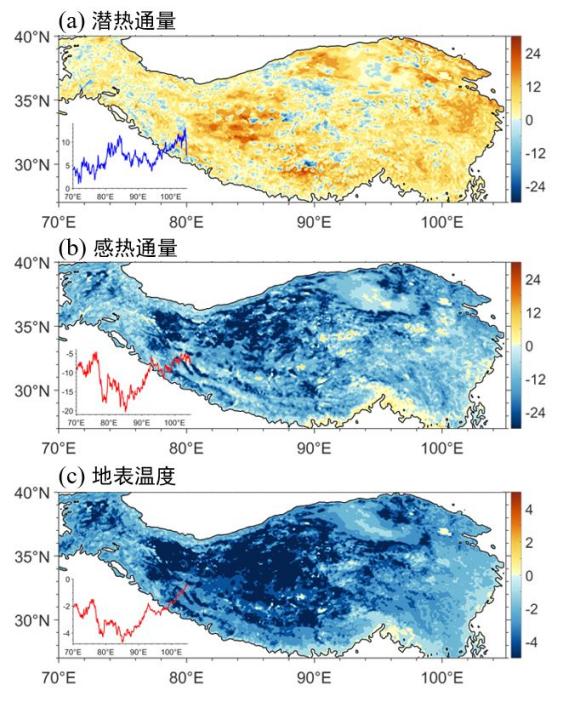
Fig. 2. (a)–(c) Spatial distributions and meridional averages (insets) of differences in monsoon-season latent heat flux, sensible heat flux, and ground temperature between the two experiments (WRF-SEN minus WRF-CTL). The black line denotes the 2500-m isoline of terrain height.
Based on WRF simulations, we find that increased evaporation and decreased sensible heat flux over the TP result in decreased 2-m air temperature and increased 2-m relative humidity; an increase over the Inner TP and Qaidam Basin, but a decrease in other regions; less precipitation on the TP, especially east of about 88°E. This suggests that the altered surface energy budget can also help to narrow the east–west contrast in precipitation amount on the TP (Fig. 3). The above results demonstrate that increase of evaporation over the TP and consequent land surface energy budget adjustment can exert negative feedback to monsoon-season precipitation on the plateau, that is, land-air interactions can attenuate the precipitation increase rate over the TP through land surface energy changes.
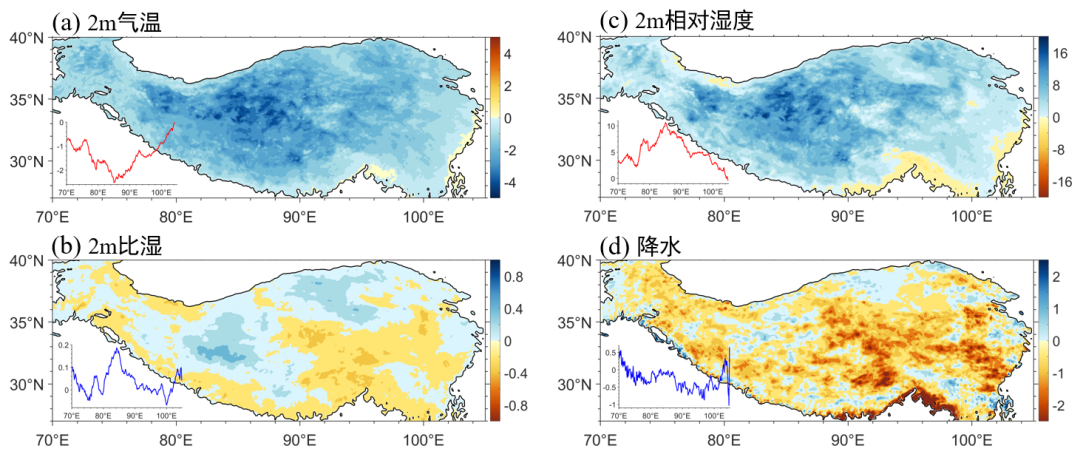
Fig. 3. (a)–(d) Spatial distributions and meridional averages (insets) of differences in monsoon-season 2-m air temperature, 2-m specific humidity, 2-m relative humidity, and precipitation between the two experiments (WRF-SEN minus WRF-CTL). The black line denotes the 2500-m isoline of terrain height.
To discover the reasons for the decrease in precipitation, the responses of air circulation to the land surface energy budget adjustment over the TP are further analyzed. The results show that enhanced surface latent heat and weakened surface sensible heat can lead to low-level anomalous anticyclonic. The decrease of the potential height in the upper troposphere leads to the weakening of the South Asian high. Due to the 500hPa anticyclonic anomaly over the TP, less water vapor from the Bay of Bengal enters the plateau from its southeastern boundary. The cyclonic anomaly in the Indian plain favors more water vapor entering the plateau from its southwestern boundary. Moreover, the stronger westerlies north of 33ºN sweep more water vapor out from the eastern boundary of the plateau. These factors lead to less precipitation over the TP, especially in its east, because the decrease of water vapor convergence caused by abnormal circulation exceeds the increase of surface evaporation.
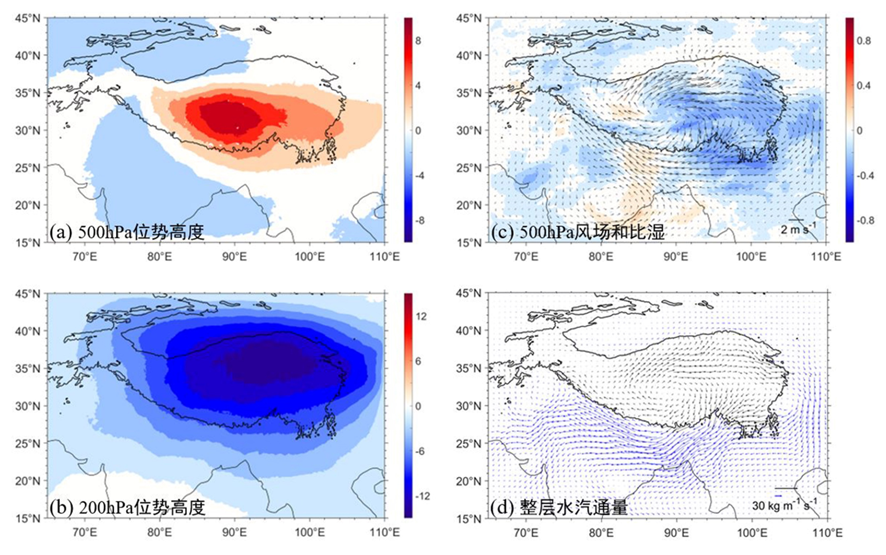
Fig. 4. Spatial distributions of differences in monsoon-season (a),(b) geopotential height (gpm) at 500 and 200 hPa, (c) specific humidity (g·kg-1; shaded) and wind (m·s-1 vectors) at 500 hPa, and (d) vertical integral of water vapor flux (kg·m-1·s-1) between the two experiments (WRF-SEN minus WRF-CTL). The black line denotes the 2500-m isoline of terrain height.
These processes are shown in Fig. 5. Although the warming and wetting of the TP increase its evapotranspiration, the decrease of sensible heat on the land surface attenuates the “sensible heat pump” effect on the plateau, which leads to the weakening of water vapor flux convergence in this area, especially in the eastern part of the plateau. This ultimately inhibits the increase rate of precipitation over the plateau in the monsoon season, that is, land surface impacts can mitigate the acceleration process of plateau water cycle under global climate change.
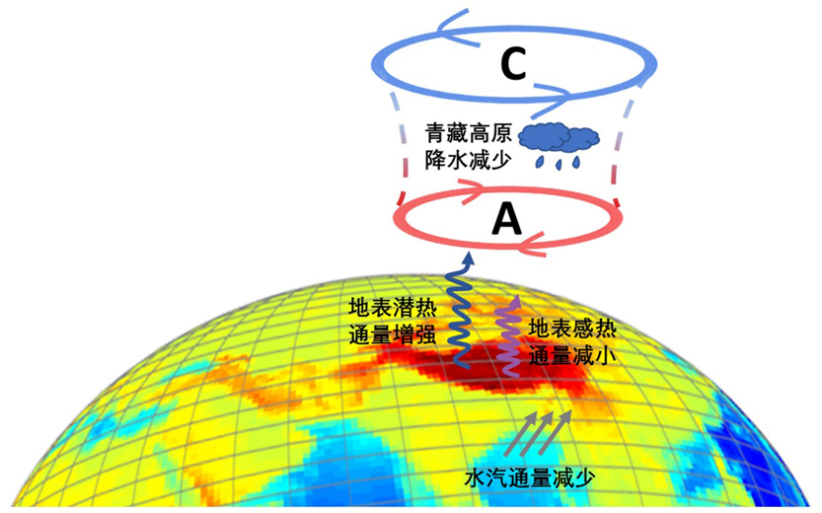
Fig. 5. The processes of interdecadal changes in surface energy budget over the TP affecting the atmosphere. The light-red ring labeled A and the light-blue ring labeled C indicate anomalous anticyclonic and cyclonic induced by the altered surface energy budget, respectively. The interdecadal changes in the TP land surface energy budget (including enhanced surface latent heat and weakened surface sensible heat) can lead to low-level anomalous anticyclonic and upper-level anomalous cyclonic, and thus weaken the South Asian monsoon, causing a reduction in moisture flux from the Bay of Bengal entering the TP and ultimately less precipitation over the plateau, especially in its east.
The related research has been published as a paper titled “Land-Atmosphere Interactions Partially Offset the Accelerated Tibetan Plateau Water Cycle through Dynamical Processes” in Journal of Climate。Sun Jing, doctoral candidate of the DESS, Tsinghua University is the first author of the paper, Professor Yang Kun of the DESS is the corresponding author, and other collaborators of the paper include Assistant Professor Yu Yan of Peking University, and Professor Lu Hui and Professor Lin Yanluan of the DESS, Tsinghua University. This work was supported by the Second Tibetan Plateau Scientific Expedition and Research Program and the National Science Foundation of China, among others.
Article information:
Sun, J., K. Yang, Y. Yu, H. Lu, and Y. Lin, 2023: Land–Atmosphere Interactions Partially Offset the Accelerated Tibetan Plateau Water Cycle through Dynamical Processes. J. Climate, 36, 3867–3880, https://doi.org/10.1175/JCLI-D-22-0686.1
Written by Sun Jing and Yang Kun
Reviewed by Zhang Qiang